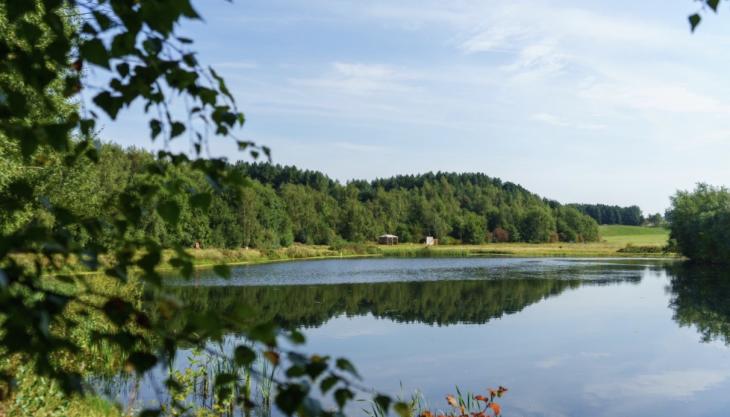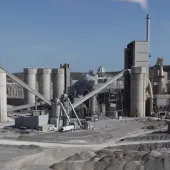BIG Award for Crown Farm Quarry

Tarmac site commended for putting nature and biodiversity at forefront of restoration work
PIONEERING work at Tarmac’s Crown Farm Quarry to safeguard and enhance the natural habitat for plants and animals has won high praise from a leading conservation body.
Rewilding and restoration projects at Crown Farm Quarry, in Cheshire, have not only protected wildlife in the area but also allowed biodiversity to flourish, according to judges in the Construction Industry Research and Information Association (CIRIA) BIG Biodiversity Challenge Awards.
Tarmac and partners Atkins, member of the SNC-Lavalin group, an engineering and project-management consultancy, were ‘highly commended’ in the awards for enhancements that have a long-term benefit for biodiversity.
The BIG Awards are designed to recognize organizations which put biodiversity at the heart of building projects. The Biodiversity Challenge to ‘do one thing’ invites the construction industry to add at least one new biodiversity enhancement to construction sites, developments, or existing buildings.
Working alongside Cheshire Wildlife Trust and Atkins, Tarmac ensure that once extractions are completed at the quarry site the land is restored to its original state or better. Ongoing since 2003, the project team has rewilded vast areas of the partially restored site.
Steven Williams, quarry manager at Crown Farm Quarry, said: ‘We have implemented habitat enhancement that goes above and beyond normal planning requirements. This has included not just habitat enhancement and restoration, but also pioneering work to rewild areas of the site. Since Atkins’ involvement, the biodiversity at the site has flourished.
‘Following the restoration, we have seen the return of all sorts of wildlife, including colonies of birds – such as sand martins, which nest in the sandbanks created by the excavators. Pollinators such as bees and butterflies (including the small heath, common blue, and small copper), and grass snakes now flourish in the restored grasslands, while naturally filled ponds and lakes have also seen an increase of rare great crested newts. A variety of bats even forage over the rewilded areas.’
The large 17ha area of the restored and rewilded quarry is managed by Cheshire Wildlife Trust as a nature reserve. Tarmac have also worked with the trust to develop and fund an on-site educational facility. The Crown Farm Discovery Centre, run by Cheshire Wildlife Trust, holds education sessions for local school children to encourage them learn about nature and how they can play their part in preserving it for the future.
Kevin Feeney, senior living landscape officer for Cheshire Wildlife Trust, said: ‘Crown Farm Quarry is locally important for some of Cheshire’s rarest wildlife; in many cases it is now the last stronghold for many plants and invertebrates that would be extinct in the county.
‘Constant collaborative work to bring wildlife back has made the restoration of the sand quarry not just a haven for nature, but also a place of engagement for people. Groups of children from local schools get to enjoy and learn about wildlife, helping to inspire the next generation of nature conservationists. Volunteers engage in regular practical conservation tasks, giving back to nature and improving their own physical and mental well-being.’
Luke Gorman, associate director (ecology) infrastructure UK & Europe at Atkins, said: ‘The work undertaken at Crown Farm Quarry is a fantastic example of what can be achieved. The site has been restored, enhanced or rewilded in stages alongside ongoing mineral extraction. Once an area has been worked, and minerals have been extracted, the land is either restored or allowed to rewild naturally.
‘Monthly ecological site visits are undertaken by Atkins, and we monitor the great crested newt population every two years. It has increased rapidly over the past 18 years from a small population to a large population.
‘The quarry is an excellent example of how biodiversity gains can be achieved even during the construction/mineral extraction phase of a scheme by using staged restoration, enhancement, and rewilding techniques. The nature reserve – and collaboration with Cheshire Wildlife Trust – allows people to engage with nature, bringing social and well-being benefits alongside biodiversity gains. The pioneering work we have undertaken, along with collaboration with the local community, is easily replicable.’
Jim McClelland, founder and editor of SustMeme and host of the BIG Awards, said: ‘During COP26 [in Glasgow], where we hope to see biodiversity and the protection of natural habitats high on the global agenda, it is a real tonic to witness the range of projects, plus the breadth and passion of the participants involved in the BIG Awards.
‘The long-lasting positive impacts and multiple, shared benefits that biodiversity enhancement brings to both the environment and society truly are something to celebrate.’








